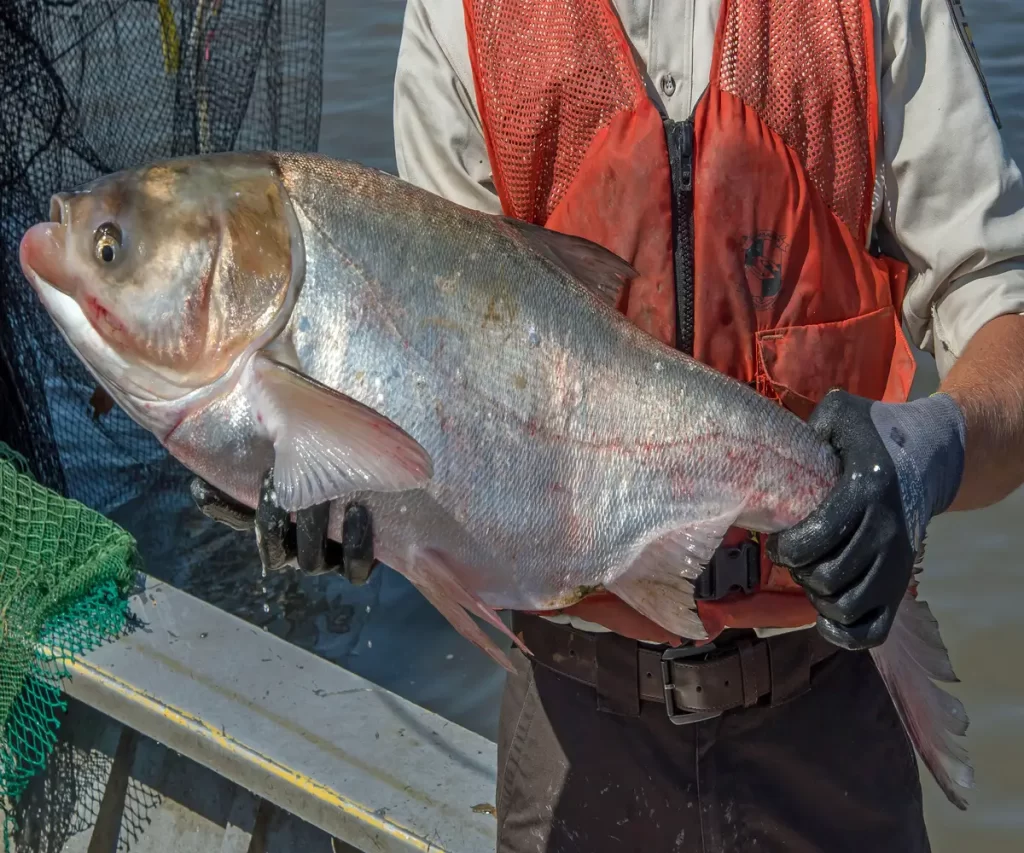
Silver Carp Fish Species Guide
Silver Carp, scientifically known as Hypophthalmichthys molitrix, is a fascinating fish species that has gained attention worldwide for its unique characteristics and impact on aquatic ecosystems. This webpage aims to provide a comprehensive exploration of the Silver Carp, covering its biology, habitat, behavior, ecological impact, economic importance, and conservation efforts.
Taxonomy and Classification
Silver Carp belongs to the family Cyprinidae and is classified under the genus Hypophthalmichthys. The species name “molitrix” is derived from Latin, referring to the silver-colored scales that characterize this fish. As a member of the Cyprinidae family, Silver Carp is closely related to other carp species, including Bighead Carp (Hypophthalmichthys nobilis) and Grass Carp (Ctenopharyngodon idella).
Physical Characteristics
Morphology
Silver Carp is known for its streamlined and torpedo-shaped body, which is adapted for swift swimming. The scales are large and silvery, giving the fish its characteristic gleam. The head is small, and the mouth is subterminal, with no barbels. One distinctive feature is the absence of a true stomach, making Silver Carp primarily a filter feeder.
Size and Weight
Silver Carp can reach impressive sizes, with individuals commonly exceeding 3 feet (1 meter) in length and weighing up to 60 pounds (27 kilograms). However, they are capable of growing even larger under optimal conditions.
Reproductive Anatomy
Silver Carp are known for their high reproductive potential. Like many cyprinids, they are prolific spawners, releasing thousands of eggs into the water. Understanding their reproductive anatomy is crucial for managing their populations and mitigating potential ecological impacts.
Distribution and Habitat
Native Range
Originally native to eastern Asia, Silver Carp was found in large river systems such as the Amur and Yangtze in China. Its historical range includes parts of Russia, Vietnam, and North Korea.
Introduction to North America
Silver Carp, along with other Asian carp species, was introduced to North America in the 1970s to control algae in aquaculture ponds. Unfortunately, they escaped into the wild and rapidly established populations in the Mississippi River and its tributaries.
Behavior and Feeding Habits
Filter Feeding
Silver Carp are filter feeders, relying on their specialized gill rakers to consume plankton and algae. This feeding strategy has implications for the ecosystems they inhabit, as they can outcompete native species for food resources.
Jumping Behavior
One of the most iconic behaviors of Silver Carp is their tendency to leap out of the water when disturbed by boat motors. This jumping behavior poses safety risks to boaters and has become a notable characteristic associated with Asian carp species.
Ecological Impact
Disruption of Ecosystems
The introduction of Silver Carp to new ecosystems has had profound ecological consequences. By outcompeting native species for food, they can disrupt the balance of aquatic ecosystems, leading to declines in native fish populations.
Impact on Water Quality
Silver Carp’s filter-feeding behavior can also influence water quality. While they consume algae, they may increase water clarity, potentially leading to changes in light penetration and affecting other organisms dependent on specific light conditions.
Economic Importance
Aquaculture
While Silver Carp’s introduction to North America was initially for algae control in aquaculture ponds, they have not been extensively used in aquaculture practices in the region. However, in their native range, Silver Carp is an essential species in aquaculture, providing a valuable protein source.
Commercial Fishing
In some regions, commercial fishing operations target Silver Carp due to their abundance. The meat is marketed for human consumption, and various products are derived from different parts of the fish.
Conservation Challenges and Efforts
Controlling Population Spread
Controlling the spread of Silver Carp and other invasive species is a significant challenge. Various methods, including physical barriers and deterrents, have been employed to prevent their movement into new water bodies.
Research and Monitoring
Scientists and conservationists conduct ongoing research to understand the behavior, ecology, and potential control methods for Silver Carp. Monitoring programs help track population trends and assess the effectiveness of management strategies.
Public Awareness
Raising public awareness about the ecological impact of Silver Carp is crucial for garnering support for conservation efforts. Educational campaigns inform the public about the importance of preventing the further spread of these invasive species.
Conclusion to: Silver Carp Guide
In conclusion, the Silver Carp is a remarkable fish species with a complex interplay of biological, ecological, and socio-economic aspects. Its introduction to new environments has raised significant challenges, but ongoing research and conservation efforts aim to mitigate its impact and preserve the health of aquatic ecosystems. Understanding the Silver Carp’s biology and behavior is essential for developing effective management strategies and ensuring the long-term sustainability of freshwater environments.